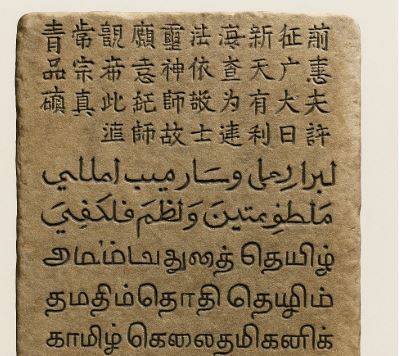UNESCO and the Trilingual Inscription: A Timeless Symbol of Cultural Dialogue

In the history of human civilization, few artifacts symbolize cultural exchange and coexistence as beautifully as the Trilingual Inscription. Recognized by UNESCO for its historical and cultural importance, this ancient artifact stands as a testament to an era when diverse languages and communities thrived side by side.
Let’s explore the significance of the Trilingual Inscription and its connection to UNESCO’s efforts in preserving world heritage.
What is the Trilingual Inscription?
The Trilingual Inscription refers to an ancient stone inscription written in three different languages. The most famous example is the Rosetta Stone discovered in Egypt, inscribed in Greek, Demotic, and Hieroglyphic scripts, which played a crucial role in deciphering ancient Egyptian writing.
In South Asia, notably in Sri Lanka, another significant Trilingual Inscription was discovered in Galle. This stone tablet, dating back to the early 15th century during the reign of the Chinese Admiral Zheng He, is inscribed in Chinese, Persian, and Tamil languages. Each inscription pays homage to different deities, reflecting the multicultural and multi-religious society of the time:
-
Chinese text honors Buddhist deities.
-
Persian text honors Allah.
-
Tamil text honors Hindu deities.
This fascinating blend highlights the harmonious relationships between diverse cultures, religions, and languages.
UNESCO’s Role in Preserving the Trilingual Inscription
UNESCO (United Nations Educational, Scientific and Cultural Organization) plays a critical role in safeguarding cultural artifacts like the Trilingual Inscription. UNESCO’s missions include:
-
Preservation and Protection: Through programs like the Memory of the World Register, UNESCO identifies and protects valuable documentary heritage that is at risk.
-
Global Recognition: By recognizing artifacts such as the Trilingual Inscription, UNESCO brings international attention to their importance and promotes their study, conservation, and celebration.
-
Promotion of Multiculturalism: The Trilingual Inscription aligns perfectly with UNESCO’s values, symbolizing the spirit of intercultural dialogue, mutual respect, and understanding among civilizations.
Sri Lanka’s Galle Trilingual Inscription was nominated for UNESCO recognition because it perfectly embodies these ideals, representing peaceful international relations in the ancient world, especially between Asia, the Middle East, and South Asia.
Historical and Cultural Importance
The Trilingual Inscription is much more than just a carved stone; it is a living document of an era when:
-
Trade routes flourished across the Indian Ocean.
-
Religious tolerance and diplomacy were actively practiced.
-
Cultural exchanges were frequent, strengthening human ties across continents.
Artifacts like these provide crucial insights into how ancient societies interacted, governed, and coexisted despite differences. They offer valuable lessons for today’s world about the importance of dialogue, understanding, and cooperation among diverse communities.
Where You Can See It
The Galle Trilingual Inscription is preserved and displayed in the National Museum of Colombo, Sri Lanka. It continues to attract historians, researchers, and tourists from around the world who marvel at its significance and the stories it tells.
Final Thoughts
The Trilingual Inscription remains a timeless reminder that languages and cultures, when embraced together, can foster peace and prosperity. Thanks to organizations like UNESCO, these priceless pieces of human history are not only preserved but also celebrated as guiding lights for future generations.
In a world often divided by differences, the Trilingual Inscription stands tall as a silent ambassador of unity through diversity — a message as relevant today as it was centuries ago.























